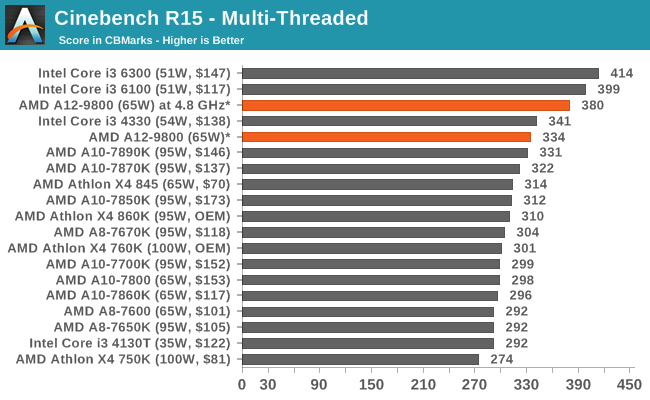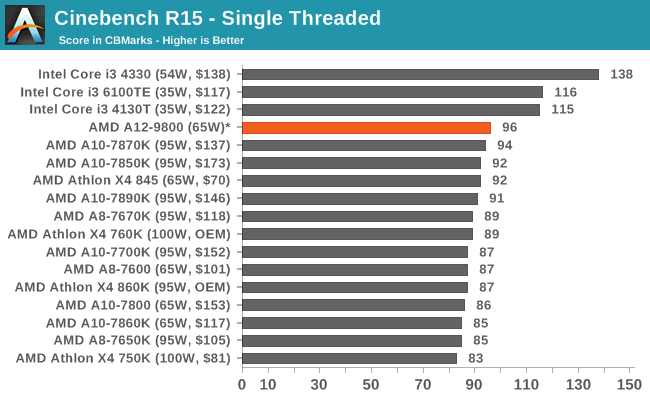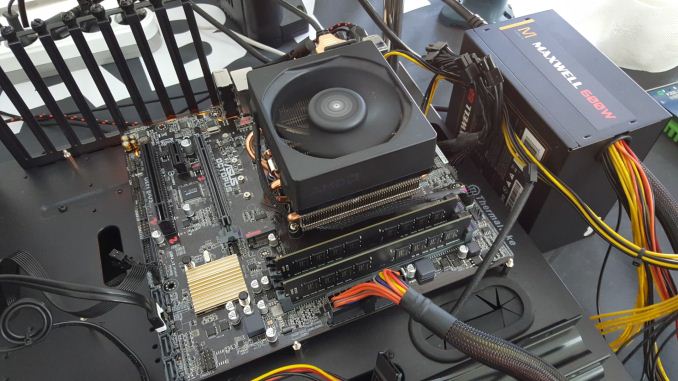AMD 7th Gen Bristol Ridge and AM4 Analysis: Up to A12-9800, B350/A320 Chipset, OEMs first, PIBs Later
by Ian Cutress on September 23, 2016 9:00 AM EST
Over the last two weeks, AMD officially launched their 7th Generation Bristol Ridge processors as well as the new AM4 socket and related chipsets. The launch was somewhat muted, as the target for the initial launch is purely to the big system OEMs and system integrators, such as Lenovo, HP, Dell and others – for users wanting to build their own systems, ‘Product-in-Box’ units (called PIBs) for self-build systems will come at the end of the year. We held off on the announcement because the launch and briefings left a number of questions unanswered as to the potential matrix of configurations, specifications of the hardware and how it all connects together. We got a number of answers, so let’s delve in.
The CPUs
The seven APUs and one CPU being launched for OEM systems spans from a high-frequency A12 part using the 7th Generation microarchitecture (we call it Excavator v2) to the A6, and they all build on the Bristol Ridge notebook parts that were launched earlier in the year but focused on the desktop this time around. AMD essentially skipped the 6th Gen, Carrizo, for desktop as the design was significantly mobile focused – we ended up with one CPU, the Athlon X4 845 (which we reviewed), with DDR3 support but no integrated graphics. Using the updated 28nm process from TSMC, AMD was able to tweak the microarchitecture and allow full on APUs for desktops using a similar design.
The full list of processors is as follows:
| AMD 7th Generation Bristol Ridge Processors | |||||
| Modules/ Threads |
CPU Base / Turbo (MHz) |
GPU | GPU Base / Turbo (MHz) |
TDP | |
| A12-9800 | 2M / 4T | 3800 / 4200 | Radeon R7 | 800 / 1108 | 65W |
| A12-9800E | 2M / 4T | 3100 / 3800 | Radeon R7 | 655 / 900 | 35W |
| A10-9700 | 2M / 4T | 3500 / 3800 | Radeon R7 | 720 / 1029 | 65W |
| A10-9700E | 2M / 4T | 3000 / 3500 | Radeon R7 | 600 / 847 | 35W |
| A8-9600 | 2M / 4T | 3100 / 3400 | Radeon R7 | 655 / 900 | 65W |
| A6-9500 | 1M / 2T | 3500 / 3800 | Radeon R5 | 720 / 1029 | 65W |
| A6-9500E | 1M / 2T | 3000 / 3400 | Radeon R5 | 576 / 800 | 35W |
| Athlon X4 950 | 2M / 4T | 3500 / 3800 | - | - | 65W |
AMD’s mainstream processors will now hit a maximum of 65W in their official thermal design power (TDP), with the launch offering a number of 65W and 35W parts. There is the potential to offer CPUs with a configurable TDP, however much like the older parts that supported 65W/45W modes, it was seldom used, and chances are we will see OEMs stick with the default design power windows here. Also, the naming scheme: any 35W part now has an ‘E’ at the end of the processor name, allowing for easier identification.
As part of this review, we were able to snag a few extra configuration specifications for each of the processors, including the number of streaming processors in each, base GPU frequencies, base Northbridge frequencies (more on the NB later), and confirmation that all the APUs launched will support DDR4-2400 at JEDEC sub-timings.
| AMD 7th Generation 65W Bristol Ridge Processors | |||||
| Modules/ Threads |
CPU Base / Turbo (MHz) |
GPU SPs |
GPU Base / Turbo (MHz) |
Northbridge Base (MHz) |
|
| A12-9800 | 2M / 4T | 3800 / 4200 | 512 | 800 / 1108 | 1400 |
| A10-9700 | 2M / 4T | 3500 / 3800 | 384 | 720 / 1029 | 1400 |
| A8-9600 | 2M / 4T | 3100 / 3400 | 384 | 655 / 900 | 1300 |
| A6-9500 | 1M / 2T | 3500 / 3800 | 384 | 720 / 1029 | 1400 |
| Athlon X4 950 | 2M / 4T | 3500 / 3800 | - | - | 1400 |
| AMD 7th Generation 35W Bristol Ridge Processors | |||||
| Modules/ Threads |
CPU Base / Turbo (MHz) |
GPU SPs |
GPU Base / Turbo (MHz) |
Northbridge Base (MHz) |
|
| A12-9800E | 2M / 4T | 3100 / 3800 | 512 | 655 / 900 | 1300 |
| A10-9700E | 2M / 4T | 3000 / 3500 | 384 | 600 / 847 | 1300 |
| A6-9500E | 1M / 2T | 3000 / 3400 | 256 | 576 / 800 | 1300 |
The A12-9800 at the top of the stack is an interesting part on paper. If we do a direct comparison with the previous high-end AMD APUs, the A10-7890K, A10-7870K and A10-7860K, a lot of positives end up on the side of the A12.
| High-End AMD APU Comparison | |||||||
| A12-9800 | A10-7890K | A10-7870K | A10-7860K | A10-9700 | |||
| MSRP | - | $165 | $137 | $117 | - | ||
| Platform | Bristol Ridge | Kaveri Refresh | Bristol Ridge | ||||
| uArch | Excavator v2 | Steamroller | Steamroller | Steamroller | Excavator v2 | ||
| Threads | 2M / 4T | 2M / 4T | 2M / 4T | 2M / 4T | 2M / 4T | ||
| CPU Base Freq | 3800 | 4100 | 3900 | 3600 | 3500 | ||
| CPU Turbo Freq | 4200 | 4300 | 4100 | 4000 | 3800 | ||
| IGP SPs | 512 | 512 | 512 | 512 | 384 | ||
| GPU Turbo Freq | 1108 | 866 | 866 | 757 | 1029 | ||
| TDP | 65W | 95W | 95W | 65W | 65W | ||
| L1-I Cache | 192 KB | 192 KB | 192 KB | 192 KB | 192 KB | ||
| L1-D Cache | 128 KB | 64 KB | 64 KB | 64 KB | 128 KB | ||
| L2 Cache | 2 MB | 4 MB | 4 MB | 4 MB | 2 MB | ||
| DDR Support | DDR4-2400 | DDR3-2133 | DDR3-2133 | DDR3-2133 | DDR4-2400 | ||
| PCIe 3.0 | x8 | x16 | x16 | x16 | x8 | ||
| Chipsets | B350 A320 X/B/A300 |
A88X A78 A68H |
A88X A78 A68H |
A88X A78 A68H |
B350 A320 X/B/A300 |
||
The frequency of the A12-9800 gives it a greater dynamic range than the A10-7870K (having 3.8-4.2 GHz, rather than 3.9-4.1), but with the newer Excavator v2 microarchitecture, improved L1 cache, AVX 2.0 support and a much higher integrated graphics frequency (1108 MHz vs. 866 MHz) while also coming in at 30W less TDP. The 30W TDP jump is the most surprising – we’re essentially getting better than the previous A10-class performance at a lower power, which is most likely why they started naming the best APU in the stack an ‘A12’. Basically, the A12-9800 APU will be an extremely interesting one to review given the smaller L2 cache but faster graphics and DDR4 memory.
A Wild Overclocker Appears!
Given that technically the systems with the new APUs have been released for a couple of weeks, some vendors have their internal enthusiasts play around with the platform. Bearing in mind that AMD has not announced any formal overclocking support on these new APUs, NAMEGT, a South Korean overclocker with ties to ASUS, has pushed the A12-9800 APU to 4.8 GHz by adjusting the multiplier. To do this, he used an unreleased ASUS Octopus AM4 motherboard and AMD’s 125W Wraith air cooler (which will presumably be bundled with PIBs later in the product cycle).
NAMEGT ran this setup on multithreaded Cinebench 11.5 and Cinebench 15, scoring 4.77 and 380 respectively for a 4.8 GHz overclock. If we compare this to our Bench database results, we see the following

For Cinebench 15, this overclocked score puts the A12-9800 above the Haswell Core i3-4360 and the older AMD FX-4350, but below the newer Skylake i3-6100TE. The Athlon X4 845 at stock frequencies scored 314 while running at 3.5 GHz, which would suggest that a stock A12-9800 at 3.8 GHz would fall around the 340 mark.

(Since writing this, a preview by Korean website Bodnara, using the A12-9800 in a GIGABYTE motherboard, scored 334 for a stock Cinebench 15 multithreaded test and 96 for the single threaded test. We've added this result for perspective.)

When we previously tested the Excavator architecture for desktop on the 65W Athlon X4 845, overclocking was a nightmare, with stability being a large issue. At the time, we suspected that due to the core design being focused towards 15W, moving beyond 65W was perhaps a bit of a stretch for the design at hand. This time around, as we reported before, Bristol Ridge is using an updated 28nm process over Carrizo, which may have a hand in this.
When we asked AMD about overclocking details on the new APUs, the return reply was along the lines of ‘No OEM systems at this time will be unlocked, and no official comment on the individual units. More details will be released closer to the platform launch for DIY users’.












122 Comments
View All Comments
DanNeely - Friday, September 23, 2016 - link
X = 1Y = 2
Z = 3
HL3 confirmed for 2017 launch.
anatol1981 - Friday, September 23, 2016 - link
Please, correct L1D info - its wrong.anatol1981 - Friday, September 23, 2016 - link
As i can see, L1-I swapped with L1-D, please, reverse them^)Mr Perfect - Friday, September 23, 2016 - link
Any chance the enthusiast grade chipset will be fabbed at the more expensive 28nm or 16nm node? Highend systems could justify the cost.Tom Womack - Friday, September 23, 2016 - link
The cost of fabbing a device at a different node is conservatively fifty million dollars; you're talking about a total reimplementation and revalidation, followed by a complete new mask set. There aren't half a million people willing to pay $100 more for an indifferent AMD chipset fabricated on a slightly shinier process.Mr Perfect - Friday, September 23, 2016 - link
That's assuming that the highend chipset was designed for the 55nm process from the start and would need to be redesigned for 28nm. If they designed the highend stuff for 28nm right from the start, it would just be fabrication cost differences.You're probably right though. They probably didn't see a big enough benefit in doing the C380(or whatever it ends up being called) at a modern node.
patrickjp93 - Tuesday, September 27, 2016 - link
Intel must be able to do it for far less, because there's no way Coffee Lake will sell that well, and it's based on the Cannonlake architecture which was originally built with 10nm in mind.Kalelovil - Sunday, September 25, 2016 - link
The desktop enthusiast market is unlikely to care for the couple of watts of power that could save.For the laptop market where power matters a lot more, I expect the Zen APU to integrate more connectivity onto the die and do away with the south-bridge entirely.
patrickjp93 - Tuesday, September 27, 2016 - link
Those are cheaper nodes due to maturity, jsyk.starlightmica - Friday, September 23, 2016 - link
HP Canada's 510-p127c spec page:http://support.hp.com/ca-en/document/c05281246
AMD A12-9000
16GB DDR4
R7 450 2Gb GDDR5, 4K over DP1.2, HDMI 1.4
180W uATX PSU :(